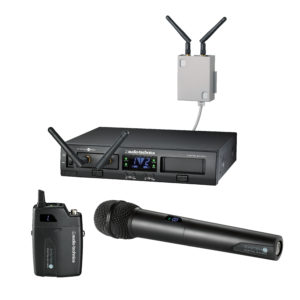Question: How do I use the Multi-Pair Function on the System 10 PRO?
Answer: The System 10 PRO technology has many benefits over traditional wireless microphone systems, benefits that range from automatic frequency coordination to operation of a fixed number of systems anywhere in the U.S. without the worry of interference from TV channels in the area. The way the technology works, though, differs in some ways from what we, as users of wireless microphones, are used to with traditional VHF and UHF systems. One difference in particular is that multiple transmitters can work with a single receiver, which we refer to here as the “multi-pair function.” Note, this does not mean that multiple transmitters can operate at the same time with one receiver. Rather, this function allows you to pair multiple transmitters with a single receiver without having to “re-pair” the transmitters each time you use them. (While we are magic makers here at Audio-Technica, we cannot change the actual physics of wireless communication… yet.)
System 10 PRO transmitters and receivers are “paired” together as both are actually transceivers which send and receive information back and forth. This allows both the transmitter and receiver to be in constant communication. One of the main benefits to this is that the receiver is constantly scanning for RF interference, and if it identifies some on the system’s current frequency it will communicate this to its paired transmitter and seamlessly change to a new frequency. While this is an amazing feature, if a user wants to change to a different transmitter, a proper pairing of the new transmitter and receiver will need to be made. Audio-Technica engineers added the multi-pair function into the System 10 PRO receivers, allowing the user to pair multiple transmitters to a receiver and then switch between those transmitters by powering them on at different times.
One scenario may be to have an ATW-T1002 handheld transmitter as well as an ATW-T1001 UniPak transmitter with an attached lavalier microphone, both paired to a single ATW-RU13 System 10 PRO receiver. One day you may use the handheld microphone to pass around the room for meetings and the next day use the lavalier microphone for a presenter. There is no need to “re-pair” the system each day, but rather just turn on the transmitter you want to use and you are off and running.
An additional scenario would be a guitar player who has two guitars, each with a different tone – let’s say a Fender Strat and a Gibson Les Paul – and each with a transmitter connected securely to the guitar strap. The Gibson may be used onstage for the first song while the Fender is offstage being tuned by the guitar technician. The technician may turn on the second guitar’s ATW-T1001 transmitter, which is already paired to the System 10 receiver, but it will not interfere with the first guitar. When the song ends and the technician hands the second guitar to the onstage player, the first transmitter is powered off and the second transmitter is ready to go almost instantly. This is important, as “dead air” onstage should be as short as possible.
So you can see why it is important for Audio-Technica to incorporate the multi-pair functionality into the System 10 PRO wireless systems. If you have any further questions, feel free to contact the Audio Solutions Department and we’ll be happy to help.